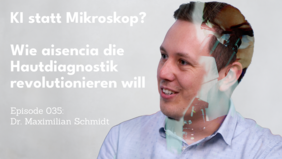AI instead of a microscope? How aisencia aims to revolutionize skin diagnostics
Max switched from industrial mathematics to skin diagnostics and explains why pathologists often work as they did 100 years ago and how aisencia aims to make a difference with AI. It's a clash of two worlds: decades of medical expertise and data-driven technology.
Max describes the entire process to Rasmus and how optical scanners enable the transition to digital analysis.
Using the example of white skin cancer, it becomes clear how an analog workflow is transformed into a digitally supported process in which AI marks changes in tissue and provides a preliminary diagnosis.
A startup emerges from a doctoral thesis: Max reports on how aisencia is supported by the EXIST program, why business expertise is crucial in the team, and how the leap from university project to market is being achieved. The question of how to get technological innovations approved in a strictly regulated environment arises early on. aisencia makes the strategic decision to first develop a laboratory information system before bringing more complex AI products to market. This approach simplifies regulatory processes and opens the way to international markets – Australia is a particular focus, not least because of its high skin cancer rate and innovation-friendly approval practices.
Collaboration with pathologists is at the heart of product development. A shortage of skilled workers and rising case numbers are making the use of AI increasingly important, but the final diagnosis remains with humans. aisencia sees AI as a tool that speeds up routine tasks and improves quality without taking responsibility out of the hands of experts.
Watch/listen now and gain exciting insights:YouTube, Spotify, Apple, Dezer

